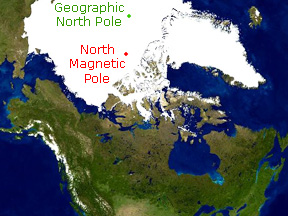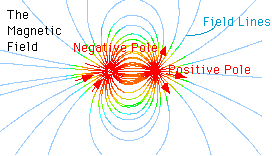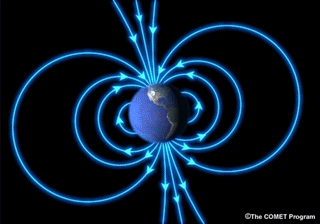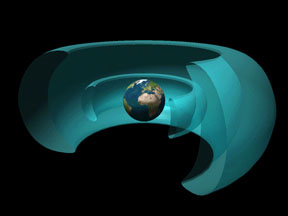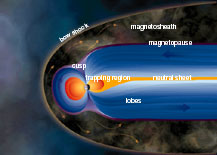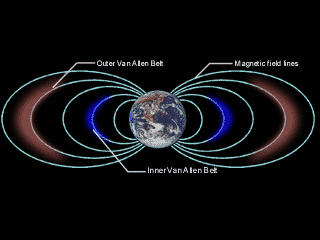Click on image for full size
Original artwork by Windows to the Universe staff (Randy Russell).
Earth's North Magnetic Pole
Earth has a global magnetic field that is approximately, though not exactly, a dipole field (like a bar magnet) with a north pole and a south pole. Earth's North Magnetic Pole (NMP) is not in the same place as the geographic North Pole. The NMP is currently located off the northern coast of Canada, several hundred kilometers (miles) from the geographic North Pole.
Earth's magnetic poles move over time. The position of the NMP can vary by as much as 85 km (53 miles) per day as a result of the interplay between Earth's magnetic field and the Sun's magnetic field as Earth rotates. Over longer time spans, the NMP can migrate significant distances. It traveled about 1,100 km (684 miles) during the 20th century. Given the NMP's current speed and heading, it would reach Siberia sometime around 2050; however, it is likely that it will change speed and direction long before then.
Since compass needles point towards the NMP, and the NMP is reasonably close to the geographic pole, the existence of the NMP has long been used to aid navigation at sea and on land. As a result of historical convention, the North Magnetic Pole is actually the south pole of Earth's magnetic dipole field! Huh? Compasses were invented long before humans had a general understanding of magnetism, and early mariners naturally thought of the northward direction that compass needles (which are small bar magnets) point as the "North Magnetic Pole". However, when dealing with magnets, like poles repel and opposites attract. The north end of the compass needle is therefore attracted by the south pole of Earth's dipole filed, which by convention (and proximity to the geographic North Pole) is still called the North Magnetic Pole. How confusing!
There are actually several similar, though slightly different, definitions for the magnetic poles. Since the poles as defined in these various ways lie close to one another, though not exactly in the same spot, for most purposes the specific definition used in describing the NMP isn't critical.
Earth's magnetic field lines converge at the magnetic poles. Charged particles in space spiral along these field lines into Earth's atmosphere, exciting atoms and molecules of gases in the upper atmosphere. The gas particles shed this excess energy as light, which we see as beautiful displays of the Northern Lights (Aurora Borealis). When viewed from space, auroral displays form circles or ovals centered on the NMP.


